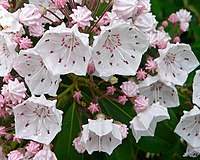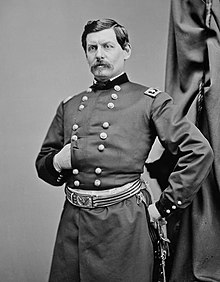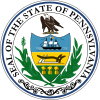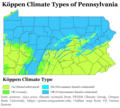Our website is made possible by displaying online advertisements to our visitors.
Please consider supporting us by disabling your ad blocker.
Portal:Pennsylvania
The Pennsylvania Portal Pennsylvania (/ˌpɛnsɪlˈveɪniə/ ⓘ PEN-sil-VAY-nee-ə, lit. 'Penn's forest country'), officially the Commonwealth of Pennsylvania (Pennsylvania Dutch: Pennsilfaani), is a state spanning the Mid-Atlantic, Northeastern, Appalachian, and Great Lakes regions of the United States. It borders Delaware to its southeast, Maryland to its south, West Virginia to its southwest, Ohio and the Ohio River to its west, Lake Erie and New York to its north, the Delaware River and New Jersey to its east, and the Canadian province of Ontario to its northwest via Lake Erie. Pennsylvania was founded in 1681 through a royal land grant to William Penn, the son of the state's namesake. Before that, between 1638 and 1655, a southeast portion of the state was part of New Sweden, a Swedish colony. Established as a haven for religious and political tolerance, the colonial-era Province of Pennsylvania was known for its relatively peaceful relations with native tribes, innovative government system, and religious pluralism. Pennsylvania played a vital and historic role in the American Revolution and the ultimately successful quest for independence from the British Empire, hosting the First and Second Continental Congress in Philadelphia that formed the Continental Army and appointed George Washington as its commander in 1775, and unanimously adopted the Declaration of Independence the following year. On December 12, 1787, Pennsylvania was the second state to ratify the U.S. Constitution. (Full article...) This is a Featured article, which represents some of the best content on English Wikipedia..
George Brinton McClellan (December 3, 1826 – October 29, 1885) was an American military officer and politician who served as the 24th governor of New Jersey and as Commanding General of the United States Army from November 1861 to March 1862. He was also an engineer, and was chief engineer and vice president of the Illinois Central Railroad, and later president of the Ohio and Mississippi Railroad in 1860. A West Point graduate, McClellan served with distinction during the Mexican–American War. He was a railway executive and engineer until the outbreak of the American Civil War in 1861. Early in the conflict, McClellan was appointed to the rank of major general and played an important role in raising the Army of the Potomac, which served in the Eastern Theater. (Full article...) Selected geography article -Quehanna Wild Area (/kwəˈhænə/) is a wildlife area within parts of Cameron, Clearfield and Elk counties in the U.S. state of Pennsylvania; with a total area of 50,000 acres (78 sq mi; 202 km2), it covers parts of Elk and Moshannon State Forests. Founded in the 1950s as a nuclear research center, Quehanna has a legacy of radioactive and toxic waste contamination, while also being the largest state forest wild area in Pennsylvania, with herds of elk. The wild area is bisected by the Quehanna Highway and is home to second growth forest with mixed hardwoods and evergreens. Quehanna has two state forest natural areas: the 1,215-acre (492 ha) M.K. Goddard/Wykoff Run Natural Area, and the 917-acre (371 ha) Marion Brooks Natural Area. The latter has the largest stand of white birch in Pennsylvania and the eastern United States. The land that became Quehanna Wild Area was home to Native Americans, including the Susquehannock and Iroquois, before it was purchased by the United States in 1784. Settlers soon moved into the region and, in the 19th and early 20th centuries, the logging industry cut the virgin forests; clearcutting and forest fires transformed the once verdant land into the "Pennsylvania Desert". Pennsylvania bought this land for its state forests, and in the 1930s the Civilian Conservation Corps worked to improve them. In 1955 the Curtiss-Wright Corporation bought 80 square miles (210 km2) of state forest to focus on developing nuclear-powered jet engines. They named their facility Quehanna for the nearby West Branch Susquehanna River, itself named for the Susquehannocks. (Full article...) Selected image -Did you know -
Related portalsWikiprojectsThis is a Good article, an article that meets a core set of high editorial standards.
 The history of Pittsburgh began with centuries of Native American civilization in the modern Pittsburgh region, known as Jaödeogë’ in the Seneca language. Eventually, European explorers encountered the strategic confluence where the Allegheny and Monongahela Rivers meet to form the Ohio, which leads to the Mississippi River. The area became a battleground when France and Great Britain fought for control in the 1750s. When the British were victorious, the French ceded control of territories east of the Mississippi. Following American independence in 1783, the village around Fort Pitt continued to grow. The region saw the short-lived Whiskey Rebellion, when farmers rebelled against federal taxes on whiskey. The War of 1812 cut off the supply of British goods, stimulating American manufacture. By 1815, Pittsburgh was producing large quantities of iron, brass, tin, and glass products. By the 1840s, Pittsburgh had grown to be one of the largest cities west of the Allegheny Mountains. Production of steel began in 1875. During the 1877 railway riots it was the site of the most violence and damage in any city affected by the nationwide strikes of that summer. Workers protested against cuts in wages, burning down buildings at the railyards, including 100 train engines and more than 1,000 cars. Forty men were killed, most of them strikers. By 1911, Pittsburgh was producing half the nation's steel. (Full article...) Selected article -The Pennsylvania State University (Penn State or PSU) is a public state-related land-grant research university with campuses and facilities throughout Pennsylvania, United States. Founded in 1855 as Farmers' High School of Pennsylvania, Penn State was named the state's first land-grant university eight years later, in 1863. Its primary campus, known as Penn State University Park, is located in State College and College Township. In addition to its land-grant designation, the university is a sea-grant, space-grant, and one of only six sun-grant universities. It is classified among "R1: Doctoral Universities – Very high research activity" and is a member of the Association of American Universities (AAU). The university has two law schools: Penn State Law on the school's University Park campus and Penn State Dickinson Law in Carlisle. The College of Medicine is in Hershey. The university maintains 19 commonwealth campuses and five special mission campuses located across Pennsylvania. (Full article...) Pennsylvania news
CategoriesState factsState Facts
State symbols
Pennsylvania topicsGeneral imagesThe following are images from various Pennsylvania-related articles on Wikipedia.
Associated WikimediaThe following Wikimedia Foundation sister projects provide more on this subject:
Discover Wikipedia using portals |
Previous Page Next Page




































































